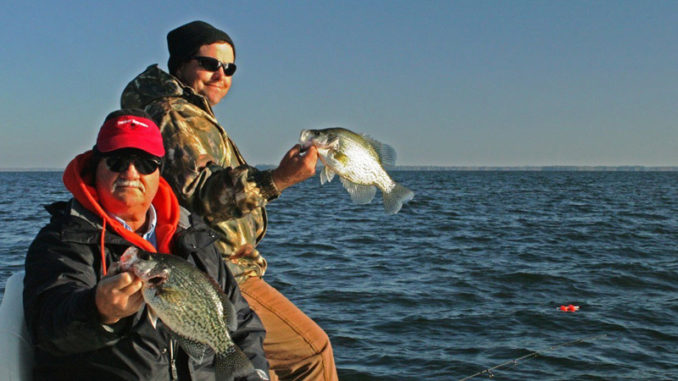
These Carolina lakes consistently produce cold weather crappie
January may be cold in terms of weather and water temperatures. But many crappie fishermen expect to catch quality and quantity of crappies this month.
The key to cold-weather crappie fishing is that the fish are in very predictable patterns, with some lakes clearly better than others. We profiled crappie fishing at several lakes that offer excellent winter crappie fishing and secrets to success from top guides.
Lake Hartwell
A deep, clear South Carolina lake known primarily for black and striped bass, Hartwell has rightfully become known as an excellent crappie-fishing destination. The lake produces plenty of slabs and limit numbers of fish on a consistent basis.
Guide Steve Pietrykowski said January kicks off outstanding action that lasts through March. this is his favorite time of the year.
“Beginning in January, crappie fishing patterns become very predictable on Lake Hartwell,” he said. “Many fishermen are surprised at the quality of crappie fishing we enjoy here because it’s a clear lake. But from cold weather right through spring, crappie fishing is on fire. We consistently catch limits, including plenty of slabs.”
Pietrykowski (864-353-3438) has been guiding on Lake Hartwell for 11 years and has learned the predictable patterns. He employs two primary techniques: long-line trolling in the creeks and fishing tightlines over sunken woody cover.
“Trolling enables me to cover much more water. It is my go-to method when crappie are scattered,” he said. “Typically, I’ll troll with jigs and plastic grubs and will experiment with colors and size combinations daily. The speed range can be crucial and will vary from 0.7 to 1.0 miles per hour in January. It may be a bit faster later in the spring.”
Look for specific targets
Pietrykowski said crappies normally orient to specific targets. He focuses on brush, submerged trees and other woody features in 10 to 30 feet of water. His targets the edges of creek channels or ditches that provide a contour change in the lake bottom.
“I prefer fishing woody cover along a depth change such as a channel ledge over finding cover over a flat,” he said. “While both produce fish, the areas oriented to depth changes hold more and larger fish and are much more likely to be consistently productive on future trips. To find fishable water, I often go well up creeks and feeder streams.”
Up in creeks, he normally tight-lines with multiple rods at specific depths, based on the depth of the target graphed. He uses jigs with live minnows instead of plastic grubs.
“I also use live minnows on a No. 2 hook with a large split-shot about 8 inches above as the weight,” he said. “Long rods with a fast tip and good backbone work best. I’ll graph to pinpoint the target, then use my electric motor to work over and around the object until we limit or action slows. If I need to move, I now have a pattern and will go to another target with a similar depth and cover situation and usually get right back to catching crappie.”
Badin Lake
Maynard Edwards of Lexington, N.C., operates Yadkin Lakes Guide Services. He’s quick to name Badin Lake as his wintertime favorite for crappie.
“I think Badin Lake is great for cold weather crappie fishing,” he said. “During January and into March, this lake is productive. The key is fishing deep water near the bottom of the lake, not for suspended fish. The typical get-your-meal-ticket-punched pattern will be crappie hugging the bottom.”
Edwards (336-249-6782) said fish are not always in extremely deep water. He often catches them in 12 to 20 feet of water and sometimes deeper.
“At times, I have to go to 30 feet and still fish near the bottom,” he said. “I use my graph looking for fish and forage. And I’ll fish depths where I mark fish. But the normal winter pattern is locating fish in 12- to 20-foot depths.
“During cold weather, I primarily target creeks and the protected coves with deep water,” he said. “The fish are not always in the deepest water. But they’ll usually orient to specific and unusual contours on the bottom. I like fishing humps and ledges in January.”
Don’t let poor weather stop you
Edwards said an ideal hump would be one whose top is in about 10 to 12 feet of water that drops to 25 to 30 feet. This area could have fish on it at some location on any given January or February day. He works down the sides and edges of the humps and drops until he finds where fish are set up that day.
Edwards said anglers should not use poor weather as an excuse not fish. Some of his best days have been when crappie were extremely deep and depth-specific in nasty weather.
“One of my best winter trips ever on Badin Lake was a day I found fish stacked up in 32 feet of water,” he said. “The amazing thing was how depth-specific they were. We caught many fish well over a pound in 32 feet of water — maybe the occasional fish at 31 feet. But we caught nothing when we tried 28 to 30 feet of water immediately adjacent to the 32-foot water where crappies were killing our bait.
“I know many crappie fishermen that catch fish working for suspended fish during much of the year,” he said. “But at Badin Lake in the winter, I’ve found that suspended fish are the exception. Working near the bottom is the rule for consistent success.”
Lake Marion/Lake Moultrie
The Santee Cooper system produces excellent year-round crappie fishing. And as January begins, experts agree that deep water is home to most of the slabs. But by the end of the month and certainly into February, crappie begin to take a turn toward shallower water.
Kevin Davis, who guides out of Blacks Camp on the Diversion Canal, fishes both Marion and Moultrie. He said January fishing is predictable.
“The primary pattern is crappies are on deep brush and other cover in depths down to 30 to 35 feet in Lake Moultrie. They are usually a bit shallower in the lower end of Lake Marion,” he said. “I target open-water humps, drops and ledges in both lakes and use my graph to locate both forage and fish. If I don’t mark what I think is crappie, I’ll move. The fish do move around a bit in January. But when I get on them, we catch slab crappie in big numbers very quickly. It does often require a bit of patience.”
Davis (843-312-3080) locates a potential hot spot with his graph. Then he fishes vertically over the top and side of the woody cover.
Start fishing at the top of the brush
“The water may be 35 to 40 feet deep. But if the brush rises to 28 feet, that’s where I begin the searching process,” he said. “I work around the cover using my electric motor to maneuver the boat. And I’ll fish progressively deeper along the edges until I find biting fish.”
Davis uses 10- to 12-foot rods and tightlines minnows, jigs or often a jig-and-minnow combination.
“I often add a minnow to a small jig. Because on some days, it simply produces more and larger crappie,” he said. “Crappies are light biters. But especially with cold weather crappie, the bite can be very subtle.”
Davis said the move toward the shallows is dependent on weather. But by late January, some crappie — but not all— are moving.
“I do see the gradual pattern of crappie beginning to move shallower by late-January, but I can stay on good fish action by fishing relatively deep water all month,” he said.
Jordan Lake
Angler adaptability is a key aspect to winter crappie fishing success, according to Freddie Sinclair of Clayton, N.C. He has been guiding for 24 years and said Jordan Lake is his favorite January hangout.
Sinclair said depth is a focal point on any given day.
“The north end of the lake is not as deep as the lower, southern part, and fish are found near the bottom in 20 to 25 feet of water,” he said. “On the lower end of the lake, it’s not unusual to find fish in 30 feet. And under severe conditions, I find them occasionally as deep as 35 to 40 feet.”
During the winter, Sinclair targets areas with depth changes including deep creek channels, humps, bends in the river and rock piles.
“Crappies are structure-oriented. And to me, structure is any change in bottom topography,” he said. “Woody cover such as brush, logs, stumps and other objects tend to congregate crappie on these areas. For example, a stretch of a creek channel ledge can be potentially good. But a ledge that has cover such as brush becomes a specific target that’s highly attractive to crappie in January.”
Sinclair employs the spider-rig, tight-line fishing method, typically fishing from eight to 12 poles, varying in length from 12 to 16 feet. He prefers 6-pound test line.
Cover lots of water at different depths
“This rigging enables me to cover a lot of water, including different depths in the water column,” he said. “I use hair jigs, jigs with curlytails and live bait, specifically small shiner minnows.”
He likes black, pink, brown and orange patterns for dingy or stained water. And he uses blue, chartreuse, red and pink for clear or slightly stained water.
Sinclair’s rig enables him to work multiple depths with two-hook rigs. He ties a jig or live bait at the end and puts an egg sinker about a foot up the line. At about a foot up the line he places an egg sinker. About 18 inches above the sinker he has a leader with another jig or hook for bait. He’ll usually mix and match jig colors and live baits until he finds the daily pattern. His prefers jig sizes of 1/32- and 1/16-ounce.
“The size of egg sinker is important,” he said. “I use the lightest I can on a given day, with wind being the determining factor. With light wind, I’ll use a ¼-ounce sinker and go progressively heavier to 3/4-ounce on windy days. I have two advantages with this rig: the lighter the sinker, the more bites I seem to get. And overall, I prefer a smaller terminal-rig profile. It makes a difference.”
“During January, I usually find the fish close to the bottom. And I key on forage and like to find threadfin shad in the area I’m fishing,” he said. “I rely heavily on my electronics. And when I mark fish, I’ll fish at or just above that depth.
“One of the best things about cold weather crappie fishing at Lake Jordan is it’s predictable,” Sinclair said. “When I find them on a specific place, they tend to stay in that area until the water begins to warm.”

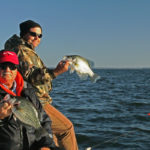
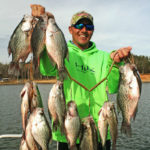
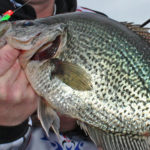
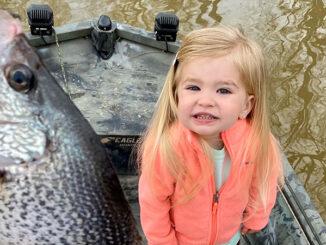
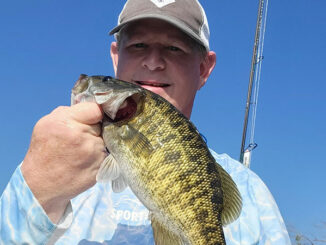
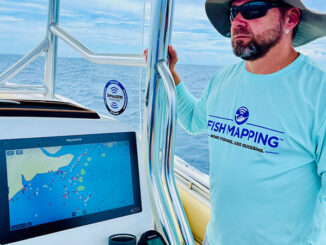

Be the first to comment